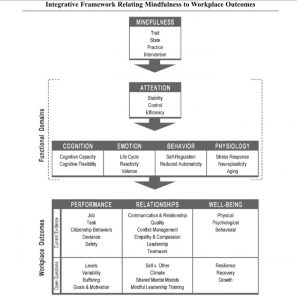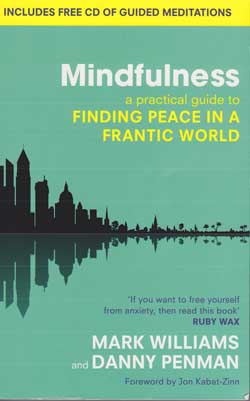
Ongoing research suggest that mindfulness practices can bring real benefits when applied in work situations. A review of research into mindfulness in work concluded:
‘mindfulness influences attention, with downstream effects on functional domains of cognition, emotion, behaviour, and physiology. Ultimately, these domains impact key workplace outcomes, including performance, relationships, and well-being’
(Good et al. 2015: 118 – 115)
So, in the second half of last year we started to deliver mindfulness courses specifically aimed at aiding people take a more mindful approach in their work and business lives.
The basis of this was the idea that we can both bring mindfulness into work and enhance how we work, and also utilise our work situations to practice and develop our mindfulness, by working in more mindful ways.
Whilst the benefits are both clear and wide ranging, the application of mindfulness into work is not always a natural transition for all, even sometimes for those who have practiced mindfulness some time. As one student pointed out:
‘I wanted to consider mindfulness in the context of my work because, while I had been able to apply what I’d learned on the original mindfulness course to my home life quite easily, it had been more challenging to do this at work’.
Course student
For our first work focused event we decided to start with the area of personal performance, given mindfulness is a very personal experience, and to built an event based on personal time management. In some ways his may not seem a natural fit, time management often being seen as about meeting future deadlines, planning, striving to achieve objects and get things done etc; areas not usually associated with being mindful.
However, what we find is that doing these without being mindful, doing them mindlessly to quote professor Ellen Langer, is not productive or good for personal wellbeing. In addition as we look into time management approaches in the business world we come to realise that actually there is also a clear need to be focused in the present, be with what is happening here and now, dealing with distractions, getting on with life without being judgemental, generally clearing the mind so that it can attend to the task in hand, and to not procrastinate.
In considering business approaches we did find parallels, such as from renowned business author and long-time teacher on time management David Allen, who talks about having a mind like water, which is:
‘a condition of working, doing and being in which the mind is clear and constructive things are happening’
(Allen 2001: 10)
Further in considering the idea of deep, focused work, Cal Newport talks about achieving:
‘activities performed in a state of distraction free concentration that push your cognitive capabilities to their limit. These efforts create new value, improve your skill, and are hard to replicate’.
(Newport 2016: 2)
Or as one of our students put it:
‘It was interesting how mindfulness and planning complement each other – to keep you focused in the moment and to the task at hand’.
(Course student)
We therefore designed a programme bringing together tried and tested techniques from the world of personal effectiveness training, combined with, and approached from, the perspective of mindfulness. This produced an series of sessions which covered three major stages, all of which integrated and overlapped. The event started with an introduction to, or development of, mindfulness, and context setting for the course. This was followed by tools and techniques of time management, approached from a mindful perspective, providing a mindful time management system.
Finally, we covered an exploration of how to integrate these into the individual environments, external and internal, of work and considered ways to implement an individual approach and application into daily working life.
As the sessions developed, four core approaches or ways of practicing emerged. Whilst all four applied to all those on the courses, different individuals found different approaches worked for them more than others, and had different relevance in different work contexts.
The first approach was that of the introduction of ideas and discussion, an opportunity to explore various ideas and gain a level of understanding to take into a more experiential approach in the other stages. This opportunity to discuss specifically worked well for some as:
‘To be with a group of like-minded individuals without having first to apologise for talking about ‘mindfulness’ – that was wonderful.’
(Course student)
However, we were very much aware that experience is key, so as ascribed to the buddha:
‘The Buddha always insisted that his disciples test everything he taught them against their own experience and take nothing on hearsay’
(Armstrong 2002: 92)
And so it was also with our courses.
So we come to the three experiential approaches. The first of these was ‘formal’ sitting (or maybe moving) meditation practice as a way of understanding yourself and how you worked, whilst at the same time developing the mind. This we saw as a sort of gym for the mind, where you can exercise, stretch and strengthen. For many, as well as learning meditations practices, this also provided an important opportunity to come together with others and meditate, enabling them:
‘to remain focused on meditation and mindfulness and reap the benefits better … to attend a weekly meditation class with others, as much as I can practise at home and work I like the sessions with others and feel I gain so much more from it’.
(Course student)
Or as another explained when discussing home practice: ‘I never really did 10 min sessions’.
Having given some attention to the development of the mind in mindfulness, we looked for ways to explore how to apply mindfulness to how we go about daily work life. This brought in the third approach of the programme, a set of mindful attitudes that could be adopted, or even just considered in daily life. These were not seen as all the attitudes, or even the ’right’ attitudes to have, but just a selection to start with. Some mindfulness exponents see such attitudes as a useful base on which to build, being:
‘a rich soil in which the seeds of mindfulness can flourish’,
(Kabat-Zinn 1994: loc 628)
For some students they become a powerful way to develop a more mindful approach:
‘I think the attitudes section [was] really thought provoking and I keep returning to how can I keep using it to help develop a more mindful approach to my work’
(Course student)
One aim of the course was a concept we ended up referring to as ‘applied mindfulness’. At the end of the day we were seeking a way in which being more mindful became a way of being and working, not just an idea, with direct impacts on working practices. So, our final approach was focused on integrated practices. This could also be seen as ‘informal’ practice; practice based in how you go about daily life. To quote Jon Kabat-Zinn again:
‘If mindfulness is deeply important to you, then every moment is an opportunity to practice’.
(Kabat-Zinn 1994:Loc 934-935)
For a large part this was based around implementing the time management system, a mindful way of working. However, as a group going through the course, we also come up with small practical ways of being more mindful, such as pausing when faced with a difficult situation. Again, here we found, for some, this was a highly beneficial side of the course:
‘The systems – OneNote – organising, not procrastinating then taking a task and doing it – such a time saver!’
‘I have definitely adopted the personal workflow system in the workplace and am still improving that system as I go along’
(Course students)
As we head into 2019 we have reviewed our approach and followed up with students. This has set the course into a six session model. It can now be run over three full days, useful for example in an organisation specific programme, or as the original set of six sessions of two and a half hours, or a series of twelve, online, sessions. Each variant we will aim to run over the coming year.
We are aware that not all people can make it to a face to face event in Leicestershire or will have an organisation specific programme to attend. We are therefore excited to be launching a live, interactive online course in the new year. This is a way to engage with those who are busy (so maybe really need better time management!) or just not local enough to an event. This means we can also reach across Europe or even further afield dependent upon time zones. These will utilise live video conferencing, as well as an online classroom, as a way to gain the interactive element of a class, enabling real time discussion and practice and ongoing interaction with other students. In addition, this approach enables students to come back later to review information, practices and even a recording of online sessions if they missed the session.
In 2019 we will also launch new work-based events such as a mindful leadership retreat, a mindful approach to change management and a mindfulness at work online community – again with live sessions and other interactions and support.
Check out the website here to see current courses, and to keep an eye out for new ones as they are launched.
We are developing ways to bring mindfulness into everyday life, which it is where it should be experienced, and to provide a potentially new way to live a more mindful life with all the benefits that brings to each of us. In doing so we are also seeking to find a range of ways for people to experience and develop. As one student highlighted:
‘I found the range of mindfulness practices useful and the constant message of finding ones that you like and connect with the most useful’.
(Course student)
It appears this has started well and works as an approach for a number of people, with typical comments such as:
‘the overall content of the programme was excellent and exceeded my expectations’.
(Course student)
In the end it is all about your practice. We look forward to seeing and practising with more of you in the coming year.
References:
Allen, D. (2001) Getting Things Done. London: Piatkus
Armstrong, K. (2002) Buddha. London: Phoenix
Good, D.J., Lyddy, C.J., Glomb, T.M., Bono, J.E., Brown, K.W., Duffy, M.K., Baer, R. a, Brewer, J. a, and Lazar, S.W. (2016) Contemplating Mindfulness at Work: An Integrative Review. Journal of Management [online]
Kabat-Zinn, J. (1994) Wherever You Go, There You Are. Kindle. London: Piatkus
Newport, C. (2016) Deep Work. Kindle edition. London: Piatkus


